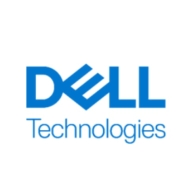


In the storage solutions category, Dell SC Series and Dell PowerMax each offer unique features. Dell PowerMax tends to have the upper hand due to its advanced NVMe architecture and data services which cater to high enterprise demands.
Features: Dell SC Series is known for its flexibility, allowing the integration of both spinning disks and flash, providing cost-effective auto-tiering, reliable performance, and seamless live migrations. It also excels in expanding capacities and configuring environments. In contrast, Dell PowerMax features an NVMe architecture known for high speed and efficiency, along with compression, deduplication, and SRDF replication, coupled with CloudIQ for comprehensive performance visibility.
Room for Improvement: Dell SC Series users often seek enhanced scaling options, better deduplication, and more intuitive management. A need for NVMe support is also frequently mentioned. Dell PowerMax, while robust, faces criticism for high upfront costs and complexity in management. Users suggest improving NAS capabilities and simplifying management tools.
Ease of Deployment and Customer Service: Both products are commonly deployed on-premises, with the SC Series also appearing in some hybrid cloud setups. SC Series is highly praised for its proactive Copilot customer support which ensures rapid responses. PowerMax’s support is similarly excellent, characterized by professionalism and prompt service, although real-time support enhancements are desired.
Pricing and ROI: Dell SC Series is favored for its cost-effectiveness and competitive pricing, delivering strong ROI through easy expansion and lower maintenance over time. PowerMax, while expensive, is justified for large-scale projects requiring high capabilities, providing significant performance gains and comprehensive features that enhance ROI, though its cost may limit broader accessibility.
By opting for the gold subscription every three years, you get a free upgrade to the latest controller release.
If you wait more than seven years to buy another one, you get a return on your investment.
During a DCDR setup and migration from VMAX to Dell PowerMax, what was planned as a two-day downtime was completed in just three to four hours.
The performance metrics or benchmarks I use to measure success with Dell PowerMax include uptime as well as our response times on our platforms, both of which are exactly where we want them to be, which is five nines and as fast as possible.
My client has seen significant ROI since the install, and when you don't go down, that's an ROI in and of itself.
Users were very happy when I bought it, as it significantly lowered disk response times.
With Pure FlashArray X NVMe, we need to escalate the issue and get an account manager for its resolution.
We also had one outage where a controller of one of the products had failed and had to be replaced on-site.
Customers always have their issues resolved promptly.
I would rate Dell PowerMax support as a ten, as I have never had an issue with Dell support as it relates to this product.
Dell support for Dell PowerMax is exceptional, rating a perfect 10 out of 10.
I evaluate Dell's support for PowerMax as very good, especially regarding their response time as well as their willingness to get ahead of issues.
Advanced support offers instant replacement without delays.
Compared to other companies, Dell SC Series offers one of the best support experiences in my career.
You cannot increase capacity if latency is present.
It is highly scalable.
It is suitable for both medium-sized and enterprise businesses.
Scalability is not an issue.
Dell PowerMax is good for enterprises, and it also depends on how much workload you're going to bring in on Dell PowerMax in terms of performance and how many users are going to use the database you're hosting.
Volumes can be defined to grow to any level without impacting overall performance.
During the eight years, there have been no problems such as hardware failure or stopping.
I would rate the stability of the solution as a ten out of ten.
I would rate the stability of the product at seven out of ten.
These patches can be applied on the fly without requiring software upgrades or system downtime.
I would rate it nine out of ten since there are no required downtimes, even during firmware upgrades.
There has been no downtime with Dell PowerMax; it's been extremely reliable, easy to manage, easy to upgrade, and trustworthy as we've upgraded over the years from one version to another.
In storages, stability is the most important aspect, even before performance.
Many options to check performance, like read, writes, random writes, and random reads, are missing in Pure FlashArray X NVMe.
We would appreciate a built-in transparent failover in the next release to eliminate the need for a separate metro cluster.
I'm eagerly anticipating the roadmap's promise of introducing multiple controllers, which could significantly boost scalability and resilience.
Compared to competitors such as NetApp, which integrates with public cloud hyperscalers (GCP, Azure, AWS), Dell PowerMax lacks in this aspect.
Dell can assist by providing plug-and-play integrated templates that allow customers to drag, drop, modify, and connect with any target system for generating snapshots without logging into the storage directly.
Dell PowerMax NVMe is very reliable storage and cannot experience downtime.
Dell PowerStore, which supports NVMe over TCP, is different and not very affordable.
In the future, I want any box that comes on-premises to have the provision to integrate with cloud storage.
While the prices may be higher than those of other vendors, we see it as a market leader with benefits.
The support can be a bit pricey, but the solution is more cost-effective than anything else out there.
Pure FlashArray X NVMe’s pricing is cheaper than other products.
The higher cost compared to other vendors is justified by additional features, vendor-managed upgrades, and superior support services.
It is the best choice for large projects in terms of price and features compared to midrange solutions.
The price is starting from $500,000.
Sometimes Dell offers better performance for less money.
Pure Storage has signature security technology, which cannot be deleted, even if you are an administrator.
The platform's robust features include excellent sustainability tracking, and a comprehensive dashboard offering insights into IOPS, bandwidth, performance, and virtual activities.
Its data compression feature is the best that we have ever seen.
NVMe provides additional fast cache, similar to random access memory (RAM), which improves overall system performance and read/write experience for users.
Dell PowerMax NVMe is very supportive of our operational growth since we require daily performance from our core banking systems and need to facilitate data movement efficiently.
The key benefits of using Dell PowerMax, quantified in terms of saved hours and saved costs, is having one single platform that provides functionality to all of our internal customers.
The storage also lowered the response time of disks across the entire farm, making it a great product for operational efficiency.
I can mix and match the drives, using older mechanical devices and the latest SFP drives in a single solution with different enclosures.



Pure Storage FlashArray//X is the world’s first enterprise-class, all-NVMe flash storage array. It represents a new class of storage – shared accelerated storage, which is a term coined by Gartner – that delivers major breakthroughs in performance, simplicity, and consolidation.
Dell PowerMax offers robust performance, reliability, and efficient data handling. It is recognized for its compression, deduplication, and NVMe technology, significantly benefiting data centers with its advanced replication and uptime.
PowerMax is equipped to handle mission-critical applications, providing impressive performance metrics with low latency and high IOPS capacity. Its CloudIQ and Unisphere interfaces enhance manageability, while REST API support simplifies storage management. Users in sectors like healthcare, finance, and telecommunications leverage its capabilities for database management, high-transaction block storage, and disaster recovery. However, opportunities for improving deduplication efficiency, interface complexity, and automation remain.
What are the key features of Dell PowerMax?Industries utilize Dell PowerMax to support diverse environments like VMware, Oracle, and PostgreSQL. It serves multiple sectors such as healthcare, finance, and government, aiding in data storage consolidation, disaster recovery, and high-availability hosting for critical systems and applications.
Dell EMC SC Series arrays provide a unified platform for the ultimate in performance, adaptability and machine-driven efficiency. SC Series software delivers modern features that help you meet aggressive workload demands using the fewest drives necessary. With an open, future-ready design, SC Series storage integrates seamlessly with applications and infrastructure, enabling you to scale on a single platform and add capabilities without forklift upgrades.
We monitor all All-Flash Storage reviews to prevent fraudulent reviews and keep review quality high. We do not post reviews by company employees or direct competitors. We validate each review for authenticity via cross-reference with LinkedIn, and personal follow-up with the reviewer when necessary.